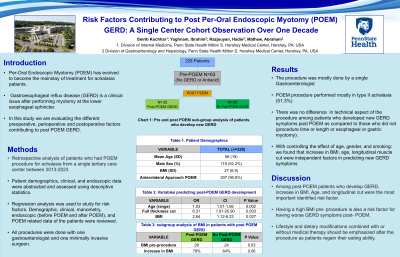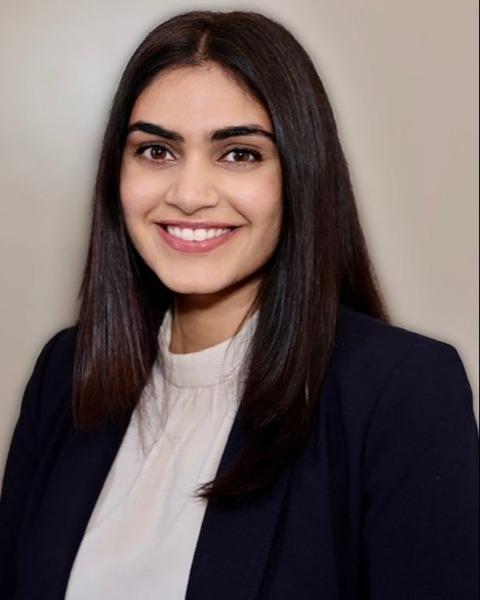Tuesday Poster Session
Category: Esophagus
P3908 - Risk Factors Contributing to Post POEM GERD: A Single Center Cohort Observation Over One Decade
Tuesday, October 29, 2024
10:30 AM - 4:00 PM ET
Location: Exhibit Hall E

Has Audio

Smriti Kochhar, DO (she/her/hers)
Penn State Health Milton S. Hershey Medical Center
Hershey, PA
Presenting Author(s)
Smriti Kochhar, DO1, Ibrahim Yaghnam, MD2, Hadie Razjouyan, MD1, Abraham Mathew, MD1
1Penn State Health Milton S. Hershey Medical Center, Hershey, PA; 2Penn State Health Milton S. Hershey Medical Center, Hummelstown, PA
Introduction: Per-Oral Endoscopic Myotomy (POEM) has evolved to become a mainstay of treatment for achalasia patients. Gastroesophageal reflux disease (GERD) is a hypothetical and clinical issue after performing myotomy at the lower esophageal sphincter. Current studies lack consistency in defining risk factors contributing to GERD after POEM. Here, we studied a large cohort of Achalasia patients who had POEM to define the post POEM GERD risk factors.
Methods: Cohort of patients who had POEM at Hershey Medical Center from 2013 to 2023 were studied. Demographic, clinical, manometry, endoscopic (before POEM and 12 months after POEM), and POEM related data of the patients were reviewed. All procedures were done with one gastroenterologist and one minimally invasive surgeon.
Results: Total of 228 patients with Achalasia [male: 52.2%; mean age (SD): 56 (19); BMI (SD): 27 (6.9)] mostly type II (51.3%) had POEM procedures, mostly done with the gastroenterologist (90.8%) via anterolateral approach. There was significant improvement in mean Echardt score (SD) [pre: 6.9 (2.4) vs. 0.8 (1.1), p: < 0.01]. 31.5% did not have GERD symptoms before POEM nor taking acid reducer medicine. One year after POEM, 35 out of 63 patients who did not have any reflux symptoms and were not taking any acid reducer medicine, developed GERD symptoms. These patients had higher mean BMI before procedure (28 vs. 24, p: 0.03) and increase in their BMI after procedure (78% vs. 64%, P: 0.06). There was no difference in technical aspect of POEM procedure including length of gastric or esophageal myotomy or procedure time among patients between those with and without reflux symptoms. A binary logistic regression on this subgroup of patients with controlling the effect of gender, smoking history, and alcohol use revealed increase in BMI (OR: 2.64, 95% CI: 1.12-6.23, p: 0.027), age (OR: 1.03, 95% CI: 1.01-1.06, p: 0.002), and longitudinal muscle cut (OR: 6.31, 95% CI: 1.91-20.90, p: 0.003) as independent risk factors in predicting new GERD symptoms.
Discussion: Post POEM GERD patients are heterogenous group of patients. Those who develop new GERD symptoms after procedure are more likely to be older patients who had longitudinal muscle cut during the procedure with subsequent increase in their BMI. The result of this study needs further validation with multi-center collaboration.
Disclosures:
Smriti Kochhar, DO1, Ibrahim Yaghnam, MD2, Hadie Razjouyan, MD1, Abraham Mathew, MD1. P3908 - Risk Factors Contributing to Post POEM GERD: A Single Center Cohort Observation Over One Decade, ACG 2024 Annual Scientific Meeting Abstracts. Philadelphia, PA: American College of Gastroenterology.
1Penn State Health Milton S. Hershey Medical Center, Hershey, PA; 2Penn State Health Milton S. Hershey Medical Center, Hummelstown, PA
Introduction: Per-Oral Endoscopic Myotomy (POEM) has evolved to become a mainstay of treatment for achalasia patients. Gastroesophageal reflux disease (GERD) is a hypothetical and clinical issue after performing myotomy at the lower esophageal sphincter. Current studies lack consistency in defining risk factors contributing to GERD after POEM. Here, we studied a large cohort of Achalasia patients who had POEM to define the post POEM GERD risk factors.
Methods: Cohort of patients who had POEM at Hershey Medical Center from 2013 to 2023 were studied. Demographic, clinical, manometry, endoscopic (before POEM and 12 months after POEM), and POEM related data of the patients were reviewed. All procedures were done with one gastroenterologist and one minimally invasive surgeon.
Results: Total of 228 patients with Achalasia [male: 52.2%; mean age (SD): 56 (19); BMI (SD): 27 (6.9)] mostly type II (51.3%) had POEM procedures, mostly done with the gastroenterologist (90.8%) via anterolateral approach. There was significant improvement in mean Echardt score (SD) [pre: 6.9 (2.4) vs. 0.8 (1.1), p: < 0.01]. 31.5% did not have GERD symptoms before POEM nor taking acid reducer medicine. One year after POEM, 35 out of 63 patients who did not have any reflux symptoms and were not taking any acid reducer medicine, developed GERD symptoms. These patients had higher mean BMI before procedure (28 vs. 24, p: 0.03) and increase in their BMI after procedure (78% vs. 64%, P: 0.06). There was no difference in technical aspect of POEM procedure including length of gastric or esophageal myotomy or procedure time among patients between those with and without reflux symptoms. A binary logistic regression on this subgroup of patients with controlling the effect of gender, smoking history, and alcohol use revealed increase in BMI (OR: 2.64, 95% CI: 1.12-6.23, p: 0.027), age (OR: 1.03, 95% CI: 1.01-1.06, p: 0.002), and longitudinal muscle cut (OR: 6.31, 95% CI: 1.91-20.90, p: 0.003) as independent risk factors in predicting new GERD symptoms.
Discussion: Post POEM GERD patients are heterogenous group of patients. Those who develop new GERD symptoms after procedure are more likely to be older patients who had longitudinal muscle cut during the procedure with subsequent increase in their BMI. The result of this study needs further validation with multi-center collaboration.
Disclosures:
Smriti Kochhar indicated no relevant financial relationships.
Ibrahim Yaghnam indicated no relevant financial relationships.
Hadie Razjouyan indicated no relevant financial relationships.
Abraham Mathew indicated no relevant financial relationships.
Smriti Kochhar, DO1, Ibrahim Yaghnam, MD2, Hadie Razjouyan, MD1, Abraham Mathew, MD1. P3908 - Risk Factors Contributing to Post POEM GERD: A Single Center Cohort Observation Over One Decade, ACG 2024 Annual Scientific Meeting Abstracts. Philadelphia, PA: American College of Gastroenterology.
